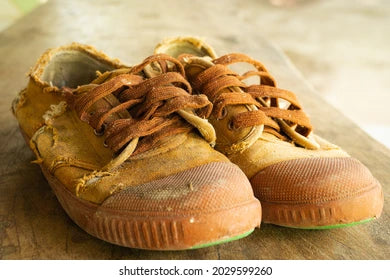Does shoe expire? They don't 'expire' like food does.
But if you use them enough, the materials (like the foam) will compress. And eventually the cushioning is toast because it has compressed to a point where it no longer cushions. You can also wear down the outer sole so that it loses tread or starts peeling off. You can wear through the mesh upper and get holes which erode the snug fit keeping your foot on the footbed.
So, I supposed they "expire" after many miles of use. I think the rule of thumb is 300-500 miles, or 200-400 for a racing flat. Many people begin to feel aches and pains when the shoe starts to wear out. I know I've used my shoes too much when the knees/hips/back/shins start hurting.
Replacing your shoes regularly is an important component of maintaining good foot health. Many of us wear shoes past their “expiration” date simply because we don’t know what to look for!
As a general rule of thumb, shoes should be replaced every 8-12 months for most people or every 500-700 kilometres for running shoes. Some shoes will last longer, and some will wear out more quickly.
One indication that your shoes might be approaching the end of their life is if you feel they are not as comfortable and supportive as when they were new. As the materials wear down, the cushioning and support begin to compress and the materials that the shoes are made of don’t “bounce back” as much as they once did.
Every foot moves differently, and mechanical factors will be different for every person. If you are harder on your feet, chances are you will wear out your shoes more quickly than “average”. This is why it is always important to regularly inspect your shoes to determine if they are wearing out a little more quickly than expected.
There are three major indicators of wear on a shoe: outsole wear, midsole compression and upper or interior wear.
To evaluate your shoes, use the following guidelines to determine if your shoes are worn out:
1. Outsole Wear
Take a look at the bottom of your shoe; if the sole is worn down excessively in any one area, it is likely time to replace them Heavily worn areas on the bottom of a pair of shoes under the ball of the foot.

“Normal” wear occurs at the outside back of the heel and evenly across the ball of the foot. If you notice any excessive wear in any other areas it may be an indication that the shoe is worn out, or that you may need a different type of shoe for your biomechanical needs
Put your shoe on a flat, even surface at eye level. Most shoes should sit evenly, without tipping or rocking. If the lugs (rubber sections) of the outsole are more worn down, the shoe may tip or rock, or even sit at an angle.
2. Midsole Compression
The midsole, or cushioning layer of a shoe, is designed to absorb shock during your activity. Typically, this layer is made from EVA which allows for mild compression during activity and rebounds after use. Over time EVA will begin to compress, with visible creases of wrinkles developing. If you notice a significant amount of creasing (pictured below), the shoe likely needs replacing. You may also notice that the shoes don’t feel quite as soft and cushioned as they once did.

3. Upper and Interior Wear
Look for any holes or unusual wear on your footwear. Pay close attention to areas that you may feel rubbing during wear ie. big toe, pinky toe, achilles, top of mid-foot, etc.

Regularly Inspect Your Footwear for Wear and Tear
- While most people do not need to replace their shoes every 6 months, it’s a good idea to take a good look at them after 6 months of use. This will give you a good indication of how fast you are wearing them down, and if the shoe is a “good fit” for your foot type and activity.

